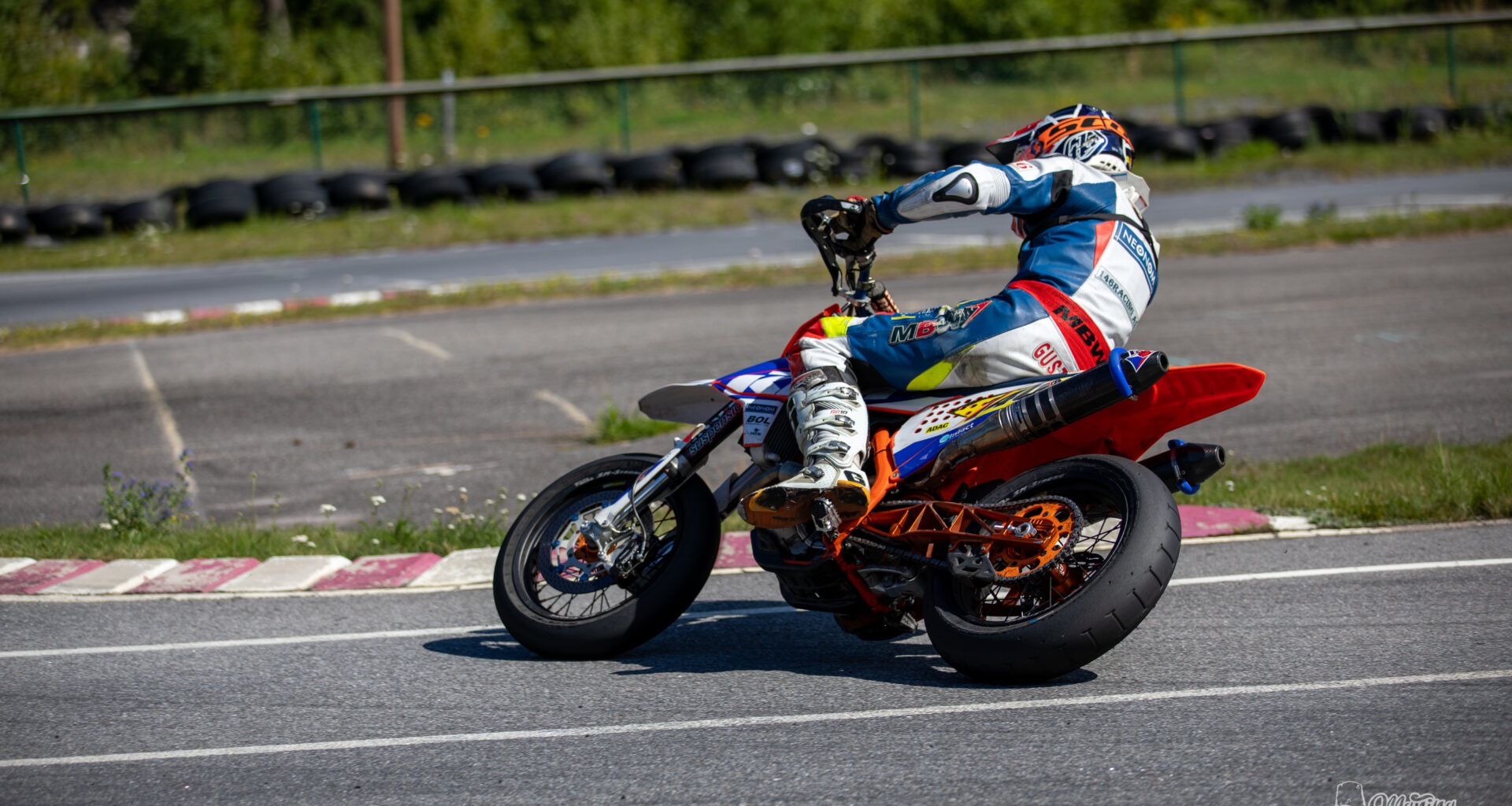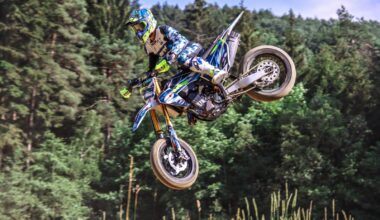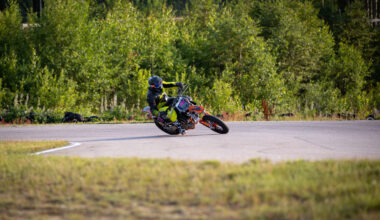There are a plethora of different aftermarket products available to purchase for our bikes. Some of them are just for show while others can actually help make the bike, and the riding, better. Replacing the stock swingarm with an aftermarket product is usually associated with a hefty sized bag of money. But do you actually get any performerance for that investment or is it just for show?
In short, these are some of the benefits from using an aftermarket swingarm:
- Potentially better grip in part due to the enabled use of wider tyres.
- A wider swingarm makes the use of tyre warmers easier.
- A swingarm built for supermoto will be stiffer (in the right places) than a swingarm built for MX/enduro.
- Supermoto-swingarms are usually shorter – the distance between the front and rear wheel will be shorter which will allow the bike to have a smaller turning radius. This might make it easier to put your front wheel on the inside of your opponent in the corners?
On the market today, there are a few different retailers of aftermarket swingarms to choose from. We’ve taken a closer look at those sold by MTR and Tekmo. The MTR swingarm will only fit the Austrian machines, KTM, Husqvarna and (now) GasGas. Tekmo, on the other hand, can offer swingarms for other manufacturers; Yamaha and Honda to name a few.
Team MTR in Italy will sell you a swingarm that, according to specification, allows the rear wheel to be moved forward 35 mm more than a stock swingarm. MTR has been on the market for a long time and has been used extensively in both the European and Word Championships. We checked the measurements of the swingarm and it turns out that the specified 35 mm move is based on an older generation of bikes, such as KTM’s 2013 models. The bikes of today have shorter swingarms so compared to a 2019 bike, the difference is only 10 mm.
Tekmo Racing developed its swingarm and started selling it in 2018. According to specification, it allows a move of the rear wheel 20mm further forward than a stock swingarm. Danish rider Simon Vilhelmsen, who has won the German championship, has been involved during the development phase. Tekmo’s product design is also something of an eye opener, have a look at the pictures below.
Both swingarms are made of aluminium and have a center piece and rear wheel mountings that are milled out of aluminum. MTR’s swingarm is welded together with side pieces of shaped aluminum while Tekmo mills out its entire swing in three parts and then bolts them together. Tekmos can be purchased anodized in different colors to match your bike while MTR allows you to choose color freely as long as you choose untreated aluminum
in order for us to get a feel for the swingarms and to get an idea about the pros and cons, we enlisted two fast riders to help us out. Hampus Gustafson and Kevin Fagré agreed to ride a couple of sessions down in Södertälje last summer.
We were fortunate enough to find a sunny day for our tests, 25 degrees warm. Perfect for those of us who would be on the side of the track but maybe a little too hot for our riders in leathers. To make sure the riders would be able to get the most out of the swingarms, we booked a trackside session with suspension guru Mattias of Eng Racing, to support us with his knowledge to get the bikes working properly.

Hampus started the day on the Tekmo while Kevin, who’s been on a racing hiatus for a while, did a few sessions to get the feeling, and speed, back with the MTR. Kevin has been riding the MTR swingarm for two years at the European Championship back in -14-15, so this was a familiar feeling to go back to Husqvarna with that swingarm. After a few sessions we noted that he started to get comfortable and his riding improved. Hampus had already used the Tekmo swingarm in Borlänge at the second race of the year, but the track at Tuvängen is a little bit different with higher top speeds and harder breaking into the slide corners. But above all, both riders got the chance to try the swingarms on the gravel.
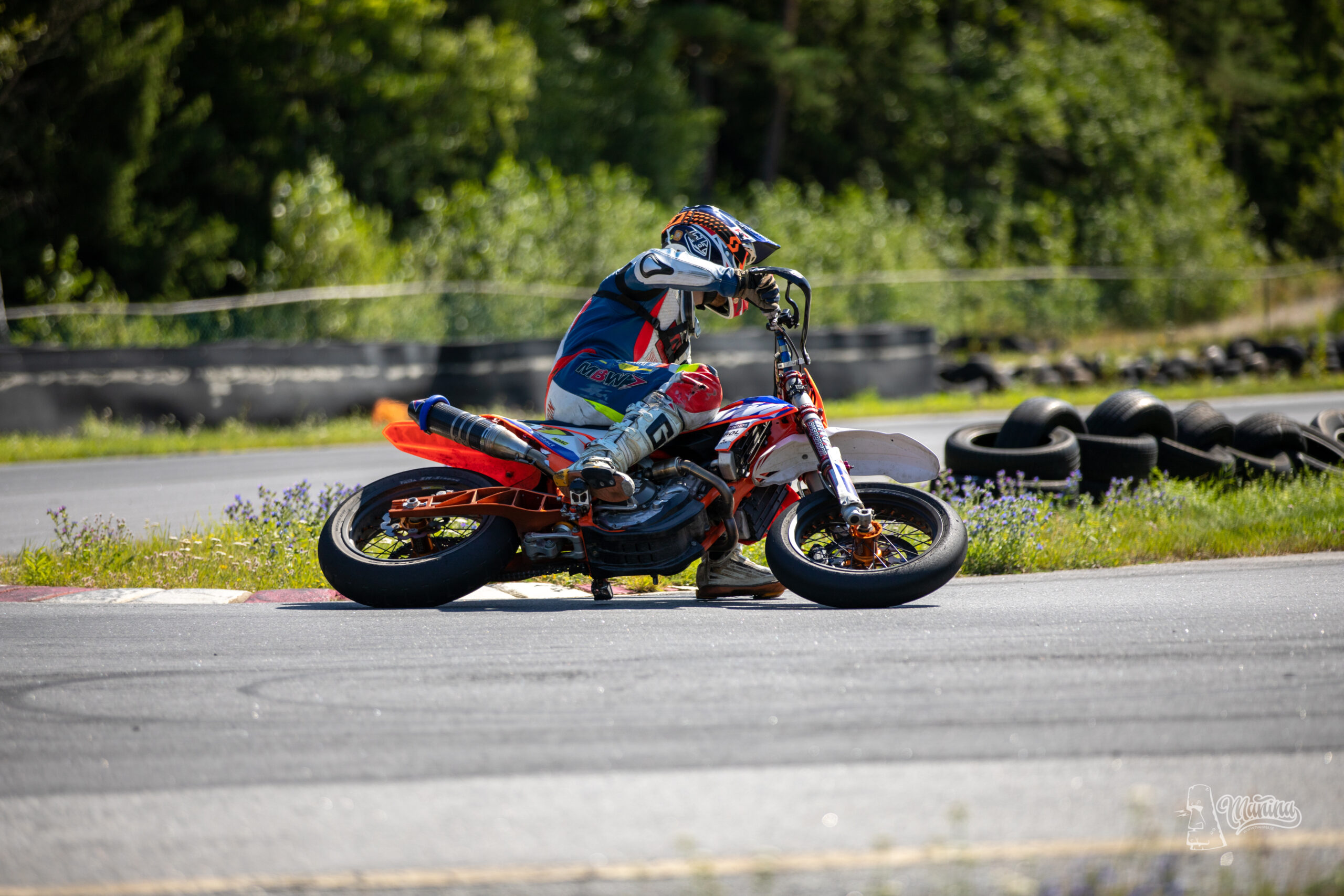
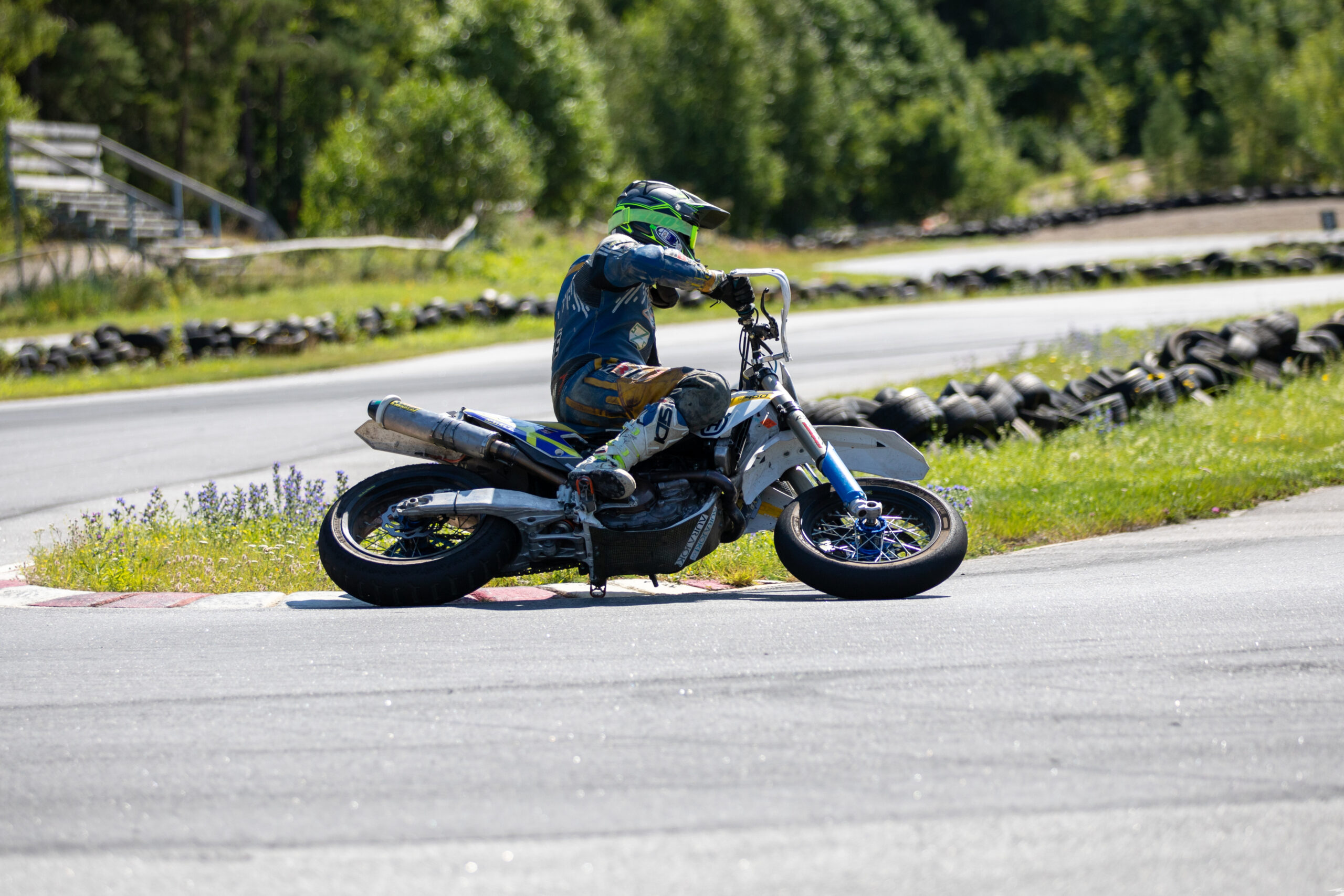
Specifications
| Swingarm | MTR | Tekmo |
| Weight (incl linkage and chain guard) | 6,4kg | 6,8kg |
| Distance in mm shorter than stock (as stated by the manufacturer) | 35mm | 20mm |
| Price | 1 650 EUR | 1 626 EUR |
Rider feedback from the tests
Tekmo
Hampus: When we raced in Borlänge I could feel that there was an instability in the swingarm. Especially when we had the rear wheel further back. When we moved the rear wheel almost all the way forward, it became more stable. In Borlänge we almost got rid of the feeling of instability completely, but at Tuvängen it appeared again, for example, after the start-finish line when you let of the throttle and turn through the small s-section. I got a vibration from the back end that went away before I applied the brake properly. However, out of the curve, I felt that it was possible to give it a little more throttle while maintaining the grip with this swingarm.
Kevin: Just like Hampus, I also felt vibrations into the corners. My Michelins (as opposed to Hampus’ Metzler) are a little more inclined to drift out of the bends (and Kevin thinks powerslides are ridiculously fun, editors note) so I never got the feeling that there would be more grip exiting the corner with the Tekmo than the MTR. But the benefit from taking the corner tighter is what makes me think the Tekmo-swingarm would be the more interesting choice to ride.
MTR
Hampus: Overall, a much more stable experience. It doesn’t do anything unexpected in any parts of the track. But the fact that it isn´t as short as the Tekmo is probably what makes it feel less fast around the track.
Kevin: I’ve been riding this swingarm a lot before todays tests. The MTR is much more stable than, for example, a stock swingarm. There are many advantages to riding with it and I have enjoyed it when I raced it. The greatest strength of MTR, however, is that it is predictable around the entire track.

Summary and speculations
Both riders preferred the Tekmo swingarm. The feeling of having a bike that you can flick into corners faster outweighed the negative parts with the rear wheel being unstable when closing the throttle and before applying the brake. The MTR swingarm is stable and predictable, which are not negative characteristics. But our test pilots preferred the swingarm where they felt they could go faster. Both test riders are experienced and have the ability to feel what is happening with the bike. A less experienced rider may not be able to handle it as well? Tekmo responded saying that the vibrations occur only when fast riders are using the swingarm. So maybe it’s a self-regulating system where riders who experience it can also handle it?
When measuring, we noticed that the mounting point for the linkage is about 10-15mm further down from the center line of the swingarm on the MTR over the Tekmo swingarm. This makes the bike lower at the rear. This, in turn, makes the bike more stable/less unstable. So the MTR swingarm, with all other factors equal, gives you a bike that is harder to turn than with the Tekmo swingarm. This can of course be remedied by changing the linkage, lowering the fork legs in the triples, adjusting the suspension or other similar adjustments. It takes time to ride and test how you want the bike to behave and it wasn´t possible for us to do in the scope of our test day. But we are convinced that the MTR swingarm can be as nimble as the Tekmo.
Our riders experinced that the Tekmo swingarm had more grip going around the corner, it was not only easier to turn in. Our guess is that the flex that the riders experienced on the straights also allows the rear wheel to straighten a little earlier than the bike when accelerating. If the rear wheel straightens, then the rear end of the bike will take a wider line out of the corner. It allows the rear end to go a little wider out of the corner with a little more rubber on the ground. It will be the same effect as if you would have drifted with a little wheel spin (you turn the bike with the help of the throttle), but in this case you maintain the grip. The result is that the Tekmo swingarm turns around the corner faster than the MTR/stock swingarm and you will have better grip exiting the corner. This is pure speculation, but it´s usually the height of the material that carries the load. And Tekmo’s swingarm has less material in that direction than MTR. So maybe Tekmo’s swingarm isn’t as rigid as MTR’s? It would also explain the vibration that both riders felt when the rear end wasn´t under load. As long as the throttle is open, there’s weight on the rear wheel. When the rider closes the throttle, the rear wheel will be unloaded. At that moment, right before the brake is applied properly, the rear wheel isn´t putting a lot of load on the swingarm but still has contact with the track and all the bumps. And this is probably the moment when the riders experience the vibrations.
Even faster riders may experience the vibrations in other situations as well. There may be a reason why most riders in the World Cup/European Championship who ride Husqvarna/KTM, chose to go with the MTR swingarm?
There are advantages and disadvantages to both swingarms. Our riders appreciated the characteristics exiting the corner with the Tekmo swingarm, they were willing to sacrifice some stability in order to get through the corner faster. It´s going to be very interesting to see if Tekmo continues to develop its swingarm and can minimize the vibrations while still maintaining the characteristics that the test riders appreciated exiting corners.
All in all, the conclusion is that an aftermarket swingarm, if you are an experienced rider who want to develop your riding further, is a good upgrade to the bike. Together with a well adjusted suspension setting.
This post is also available in: Svenska

